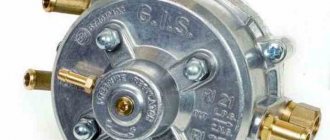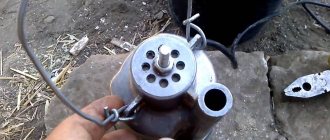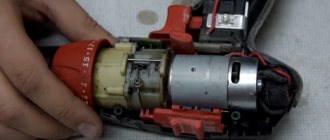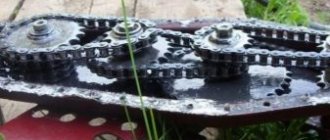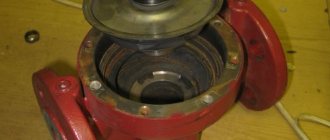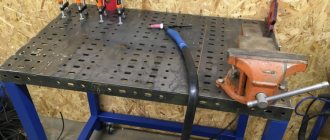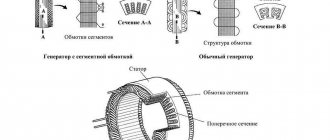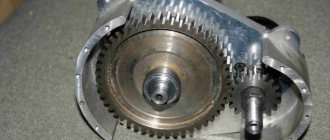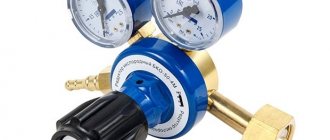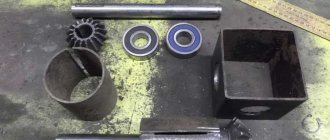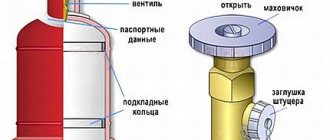Malfunctions. Repair.
If you decide to carry out repairs or adjustments yourself, make sure you have the necessary qualifications. Poor repair of gas equipment can cause a fire, explosion or poisoning. After completing the work and assembly, make sure that the device is tight and operates correctly. The tightness is checked by applying a soap solution to all joints. No bubbling indicates there is no leak. But you shouldn’t delude yourself. The tightness will need to be checked several more times (after a day, three days, a week of operation), and then checked regularly, since a leak may occur some time after the start of operation.
Main malfunctions: the gas pressure at the outlet does not correspond to the nominal value (reason: the spring is broken or deformed), gas leakage (reasons: the membrane is damaged, the tightness of the connection between the membrane and the housing is broken, the float valve is leaking)
Here is a selection of materials:
IN
Everything you need to know about heating and climate control Features of the selection and maintenance of boilers and burners. Comparison of fuels (gas, diesel, oil, coal, wood, electricity). Do-it-yourself ovens. Coolant, radiators, pipes, heated floors, circulation pumps. Chimney cleaning. Conditioning
If the float bypass valve leaks, then the leak may not occur in the reducer itself, but somewhere further, for example, in a gas stove, since in this case, in zero consumption mode (when the stove or some other consumer is turned off), at the outlet reducer and gas pipes, the pressure can reach the inlet pressure. Gas gradually leaks through the valve, and there is nowhere for it to go. If there is a gas cylinder at the inlet, the pressure can reach 15 bar, which is 500 times higher than the nominal one. Such pressure will definitely lead to leakage. At the same time, it is difficult to detect this malfunction, since when the stove is turned on, the pressure normalizes. There is no sign of overpressure (flame blowout). The fault can only be identified by measuring the outlet pressure in zero consumption mode. It can be no more than 20% more than nominal.
To repair, the gearbox must be disassembled. Only a dismountable gearbox with a spring can be repaired. Sealed gearboxes are not suitable for repair.
In the picture, the membrane is with the bottom side up.
An inspection will show if there are defects in the membrane or a broken spring. A torn membrane can be replaced. But it’s not worth it, it’s better to buy a new gearbox, since it’s quite difficult to hermetically connect the new membrane with the washers. A broken spring can be replaced. Most often, the spring does not break, but simply compresses a little over time. As a result, the outlet pressure becomes lower than nominal. This malfunction can be easily corrected by placing a gasket between the housing and the spring. Read about this below in the section on transferring to another pressure.
Membrane - top view.
If you have diagnosed problems with the bypass valve, then you need to inspect it. It is a tube with a thin hole. A piece of hard rubber mounted on a rocker arm is pressed against the end of the tube. The valve may not close for the following reasons: Firstly
, the mobility of the rocker arm is impaired.
Move it with your hands, make sure it moves freely. If there are problems, grind or replace the hinges. Secondly
, a piece of rubber was worn out and torn.
It can be removed with a sharp knife and replaced by gluing another one of the appropriate size in its place. Thirdly
, the end of the inlet tube may not be smooth, with damage and roughness. This prevents a tight seal. The end can be sanded with fine sandpaper.
Very often, a leak occurs due to a leak in the seal between the membrane and the lower part of the housing. Troubleshooting is easy. You need to lubricate the edge of the lower part of the case where the membrane fits with silicone sealant, let it dry a little (10 minutes), install the membrane, assemble the gearbox and let it dry a little more (2 hours).
During disassembly and subsequent reassembly, it is quite easy to break the tightness of the membrane. If you have disassembled the gearbox, then during reassembly in any case, even if there was no leakage, use silicone sealant. This will improve reliability.
Stages of work
Before replacing automobile gas equipment, we will diagnose the car, identify the cause of the problem and determine the type of malfunction. Based on the data received, our technicians will repair or replace the car’s gas device with new equipment of the appropriate generation.
Our advantages
| Service | Price |
| replacement of 4th generation gearbox | from 6000 rubles |
| replacement of a traditional gearbox | from 5000 rubles |
If you are looking for where to repair and replace automotive gas equipment of 1-4 generations at an inexpensive price, call us at +7 (925) 470-79-47.
Source: power-gas.ru
Conversion to a different pressure
Sometimes it becomes necessary to obtain non-standard pressure at the outlet. For example, having bought a stove for natural gas, I wanted to convert it to a bottled one. The usual way is to replace the injectors and low gas flow screws, but there is another way - to use a 12 mbar reducer. Such reducers are commercially available, but they are rare and difficult to buy. You can remake the usual one.
I will say right away that not every reducer can be converted to any pressure. There are the following restrictions. The ratio of the areas of the membrane and the inlet port, multiplied by the rocker arm, should be one and a half times greater than the ratio of the maximum inlet pressure and outlet pressure. Otherwise, the force developed by the membrane under gas pressure will not be enough to reliably close the inlet valve. In practice, it is usually easier not to carry out these calculations, but to configure the gearbox experimentally. All the same, to carry out calculations it needs to be disassembled in order to measure the area and lever of the rocker arm.
For remodeling, it makes sense to buy a gearbox in which the mounting screws are accessible and not covered in paint. The modification comes down to changing the elasticity of the spring. Let's disassemble the gearbox. If the pressure needs to be made less than it was, then shorten the spring a little (by half a turn), if more pressure is needed, then place a spacer between the gearbox housing and the spring. When installing the gasket, be careful not to block the hole in the housing. We assemble and check the gas pressure at the outlet. Repeat until the desired pressure is achieved. If after the next shortening the pressure turns out to be less than necessary, then the spring can be stretched a little or a gasket can be placed.
If it turns out that the outlet pressure is too high, even in the complete absence of a spring, then the relationship described above is not observed. The selected reducer cannot be converted to the required pressure.
When the elasticity is selected, you need to finally assemble the gearbox by applying silicone sealant between the bottom of the housing and the membrane.
Diagram of direct and reverse acting devices
Direct-type devices have the following operating scheme: propane entering the high-pressure zone presses the valve away from its seat. Propane enters the working chamber, filling it and increasing the pressure in it. It acts on the membrane, compressing the main spring. The membrane goes down, pulls the stem and closes the valve when the operating pressure value is reached. During the use of propane, the pressure in the working chamber drops, high-pressure propane opens the valve again and gas enters the working area again.
Direct action gearbox diagram
In reverse type devices, the valve is opened by the main spring, overcoming the force of the high pressure gas. After the working area is filled and the pressure reaches the set value, the rod moves down, closing the valve. As propane is used, the pressure in the working area decreases and the spring opens the valve again.
Reverse gearbox diagram
Reverse-acting devices are considered more reliable and safe. They have gained popularity in household and professional applications.
How does a cylinder reducer work:
1 Direct gearbox
An ordinary simple gas pressure reducing device consists of two chambers with an area of high and low pressure, separated by a rubber membrane. In addition, the “reducer” is equipped with an inlet and outlet fitting. Modern devices are designed in such a way that the bellows connection is screwed directly into the gearbox. Increasingly, you can find a gas reducer with a third fitting intended for mounting the monomer.
After gas is supplied through the hose and then through the fitting, it enters the chamber. The created gas pressure tends to open the valve. On the reverse side, a shut-off spring presses on the valve, returning it back to a special seat, popularly called a “saddle.” Returning to its place, the valve prevents the uncontrolled flow of high-pressure gas from the cylinder.
Membrane
The second acting force inside the gearbox is a rubber membrane that divides the device into high and low pressure areas. The membrane acts as an “assistant” to high pressure and, in turn, tends to lift the valve from the seat, opening the passage. Thus, the membrane is between two opposing forces. One surface is pressed by a pressure spring (not to be confused with the return spring of the valve), which wants to open the valve, on the other hand, the gas that has already passed into the low pressure zone presses on it.
The compression spring has manual adjustment of the pressure applied to the valve. We advise you to buy a gas reducer with a seat for a pressure gauge, this way it will be easier for you to adjust the spring pressure to the desired output pressure values.
As the gas leaves the reducer to the source of consumption, the pressure in the working space chamber decreases, allowing the pressure spring to straighten. She then begins to push the valve out of the seat, again allowing the device to be filled with gas. Accordingly, the pressure creeps up, pressing on the membrane and reducing the size of the pressure spring. The valve moves back into the seat, narrowing the gap, reducing the gas filling of the reducer. The process is then repeated until the pressure equalizes to the set value.
It should be recognized that gearboxes for direct type gas cylinders, due to their complex design, are not in high demand; reverse type gearboxes are much more widespread; by the way, they are considered devices with a high degree of safety.
2 Reverse gearbox
The operation of the device consists of the opposite action described above. Liquefied blue fuel is supplied to a chamber where high pressure is created. The bottled gas accumulates and prevents the valve from opening. To ensure gas flow into the household appliance, you need to turn the regulator in the direction of the right-hand thread.
On the back of the regulator handle there is a long screw, which, when screwed, presses on the pressure spring. As it contracts, it begins to bend the elastic membrane to the upper position. Thus, the transfer disk, through the rod, exerts pressure on the return spring. The valve begins to move and begins to open slightly, increasing the gap. Blue fuel rushes into the gap and fills the working chamber with low pressure.
In the working chamber, in the gas hose and in the cylinder, the pressure begins to increase. Under the influence of pressure, the membrane is straightened, assisted in this by a constantly compressed spring. As a result of mechanical interactions, the transfer disk lowers, weakening the return spring, which tends to return the valve to its seat. By closing the gap, the flow of gas from the cylinder into the working chamber is naturally limited. Then, with a decrease in pressure in the bellows liner, the reverse process starts.
In a word, as a result of checks and balances, the swing can be balanced and the gas reducer automatically maintains balanced pressure, without sudden jumps and drops.
Heating a country house with bottled gas
To create a high-quality heating system for a private home, gas boilers are usually used. Compared to alternative heating appliances, they are the most cost-effective and easy to use. But what about those who do not have the opportunity to connect a private home to a centralized gas pipeline? From this article you will learn whether it is possible to heat a house with gas from cylinders and how to properly set up safe heating with gas cylinders.
- What is more profitable - to use a convector or a cylinder?
- Proper storage is the key to safety
- Advantages of gas cylinder heating
- Disadvantages of heating with liquefied gas
Types of gas reducers
From the school course, the concept of non-flammable – inert gas – comes to mind. This broad group includes nitrogen, argon, helium, neon, etc. they do not support combustion and do not burn. It is widely used as a shielding gas during welding. On the other hand, there are flammable gases (butane, hydrogen, methane, propane, propylene, etc.), which either liquefy or compress and then move their cylinders. So, in order to prevent confusion, engineers, even at the production stage, suggested cutting versatile threads.
Thus, a gas reducer intended for use in the group of flammable gases is manufactured with a left-hand thread. The opposite thread turning to the right provides a gas reducer for inert gases. Among other things, manufacturers use color dyeing to promote brighter highlighting.
Before buying a gas reducer for a cylinder, we advise you to pay attention to the throughput of the device. The optimal solution would be to buy a 2nd generation gas reducer. Before making a purchase, you must make sure that the selected model meets the gas flow parameters sufficient for the consuming device.
Application
Gas reducers are widely used in households and private households. They are operated on all types of gas and are used in a wide variety of industries. Gas reducers can be found in agriculture, in the construction industry, in medical institutions, and simply in a country house.
For example, an oxygen reducer is used both in welding work and in providing medical care. As for acetylene gas reducers, you can find them in any mechanic shop.
Propane reducers are indispensable during construction work; you cannot do without them in activities related to laying roofing and bitumen materials. A gas reducer for a propane cylinder has become not a luxury, but a necessity; with its help, millions of housewives regulate the pressure coming from the cylinders to the gas stoves. A propane reducer often has a funny name, and if you ask in a store whether you can buy a frog reducer for a gas cylinder, then rest assured, the seller will perfectly understand your request.
Reducer for gas cylinder
Since we are choosing a reducer for a gas cylinder, we consider it necessary to touch upon the topic of the container itself. The technological process and widespread introduction of new innovative materials are bearing fruit. You can increasingly find new composite cylinders on the market, replacing the old generation. Modern models, unlike outdated predecessors, have less weight and offer a greater level of safety. The latest manufacturing technologies undergo multi-level testing; at testing sites, the composite cylinder is subjected to an explosion, but even after such tests you will not find small fragments.
Gas reducers for gas cylinder, price and types
Let's try to choose a reducer for gas cylinders, from those popular types that are in greatest demand among consumers. Let’s take a look at the gas appliance market and find out what the price for a gas reducer for a cylinder was at the end of 2017.
Household gas reducer RDSG for propane stabilization
The leading position in the market, and among consumers in the country, is occupied by the RDSG-1-1.2 “Frog” device with a threaded fastening. The RDSG-2 Baltika gearbox equipped with a threadless connection is not inferior in popularity. Both leaders represent the simplest design. As a result, they can offer the lowest possible cost. Specifications: — inlet pressure from 0.7 to 15.7 Bar; — the output pressure lies in the adjustment range from 30 to 32 mBar; — device weight 310 g; — permissible operation in the range from -30 to +45 ±3 °C; — gas throughput characteristic — 1.2 m3/hour. You can buy a gearbox RDSG 2-1.2 Baltika or RDSG 1-1.2 Frog for up to 350 rubles.
What does it represent?
The reduction mechanism, depending on its purpose, has a body painted red . It has the inscription “Propane” in paint. Unregulated devices have a convex body from which 2 pipes emerge for connection to the cylinder and hose of the working mechanism.
The gas reducer with a pressure regulator for propane has a valve, 1 or 2 pressure gauges, depending on the purpose . On semi-professional devices, the device shows gas flow and sets the pressure based on it. Professional models are chosen for welding machines. Using instruments, you can determine not only the gas supply speed, but also the pressure in the cylinder.
Types of reducer for gas cylinder
Among numerous industrial inventions, the leading place belongs to shut-off valves used as valve-type regulators (reducers) for gas cylinders.
The purpose of the reducer for a household gas cylinder is to reduce and maintain the vapor pressure of liquefied gas coming from the cylinder within regulated limits.
The industrially manufactured gearbox NZGA RDSG-1-1.2 is a case-type regulator for constantly preset parameters of the gas mixture:
- the pressure of the supplied mixture at the inlet in a household gas cylinder is 0.07-1.6 MPa
- regulator pressure 2000-3600 Pa at outlet
- minimum gas consumption 1.2 m3/h.
The reducer is installed in a horizontal plane relative to the cylinder valve. The regulator has factory settings that ensure that the mixture parameters are maintained after filling household gas cylinders that are commonly used. The liquefied gaseous medium in the cylinder remains under a pressure of 15 bar. Using a propane reducer, the pressure is reduced to 36 mbar.
It is clear that any deviation from the specified parameters of the gas pressure reduction system can result in an accident. Helpful tips can help you avoid trouble.
Useful tips
The design of the NZGA RDSG-1-1.2 gearbox is simple. A single-stage round diaphragm reducer ø 52 mm without external adjustment elements and control pressure gauges measuring 150x105 mm is connected to a propane (LPG) cylinder of valve type VB-2 with a standard union nut with a left-hand thread.
Connecting dimensions are:
- inlet - nut SP 21.8LH 14/1″
- output - gas sampling fitting for DN 9.
It would seem that everything is simple to connect the regulator, daily adjustment and supply of gas to the consumer.
However, during the operation of gas equipment, malfunctions of the gas reducer cannot be ruled out. Most users repair the gas reducer using the services of gas services. You can troubleshoot problems yourself.
Klimovs-Travels
A few words to a small database of experience in dealing with gas gadgets and equipment...
The most important thing you need to remember if you are going to connect a gas cylinder to any gas equipment is not to use such a “Soviet reducer”. The quality of its performance is lame and what pressure it produces in the end and what it will produce after some time is absolutely impossible to predict.
When I installed a gas stove in a motorhome, I initially connected it to a regular steel cylinder using just such a reducer. The stove did not light up well, the flame was uneven, the system was constantly working, cutting off the gas supply when it died out
By the way, I use a DOMETIC SMEV PI8621RP gas stove in my camper and am very pleased with it. Having carefully studied the sticker attached to it, I found out that it requires a reducer with an outlet pressure of 30 mbar
This reducer (GOK reducer for a 30 mbar composite cylinder) has been working perfectly for almost four years with this stove. By the way, it’s not very expensive, so there’s definitely no point in saving here. Accordingly, if you are going to use it with a composite cylinder (and this is correct), then you need the one with the “KLF cylinder connection type”
By the way, a similar gearbox is also used on the Napoleon Grill gas grill, but it comes with a gearbox, so there won’t be any problems with choosing the right one. It differs from the above in the volumetric gas flow rate, which here is not 1.5 kg/h, but only 1 kg/h
Actually in this photo we see the same composite cylinder with a KLF connection
These connections also need to be dealt with. This is what this KLF looks like. Here I am demonstrating a slightly different gearbox (more on it a little later), but this does not change the essence - pay attention to the type of connection
If for some reason you want to connect a KLF reducer to a regular “Soviet” steel gas cylinder, which has a so-called CIS connector, then you will need a CIS-KLF adapter, which looks like this (in this photo the adapter is already screwed on)
After which you can safely connect KLF reducers to it without any unwanted gas leaks
But the variety of gearboxes does not end there, because in addition to conventional burners with +/- standard power, there are powerful and super powerful burners for cauldrons and woks
To connect a Wolmex gas burner with a power of 20 kW (this is where the cauldron is located in the photo above), you need a special gearbox that can provide this baby with normal “power” with an outlet pressure from 0.5 bar to 4 bar
Now it costs a little more, but unfortunately you won’t be able to save money here. Once I was forced to connect such a burner to the gearbox from a 30 mbar camping stove and this design, instead of melting the cauldron in a couple of minutes, had difficulty heating it up in 30-odd minutes
By the way, my new toy Dutch oven fits perfectly on this burner and works great on it in cases where the recipe does not require adding heat from above. This life hack was taught to me by Australian friends on Facebook, for which I thank them very much.
This concludes my story about the variety of gas reducers and how to connect and use them
Another useful post from a series of concentrated experiences on camper construction about water supply can be read here...
Add a comment Cancel reply
You must be logged in to post a comment.
Gas reducer malfunctions, repairs
Malfunctions of the gas reducer can be associated with a discrepancy between the pressure rating of propane or the gas mixture at the outlet, leading to deformation and damage to the internal elements of the regulator: membrane, spring, end of the bypass valve and gas leakage.
Naturally, determining the cause of the malfunction will require certain knowledge and skills. You can find out the cause of the malfunction and carry out independent repairs by disconnecting the fittings and disassembling the regulator body.
Let us tell you that to determine the pressure level it is recommended to use the following parameters:
- reducer diaphragm dimensions
- type and characteristics of the reducing spring
- mechanical force to close the bypass reducing valve.
Let us tell you that the “frog” reducer is an unregulated pressure option. More complex reduction systems are used for customized automotive systems.
membrane replacement
The NZGA RDSG-1-1.2 gearbox diaphragm is a round liner made of oiled rubber-fabric oil- and petrol-resistant fabric with a thickness of δ=3 mm, secured along the circumferential markings by the housing cover.
A possible cause of the defect is a violation of the tightness between the membrane and the housing. The malfunction is eliminated to create a better fit of the membrane by lubricating the edge of the lower housing with sealant. The above-membrane part of the body has an upper hole that provides communication with the environment.
replacing the reducing spring
The reducer for gas cylinders uses a long 1st degree reduction spring with parameters D=15.5, d=1.4, number of turns 12-14, balancing the force of the membrane and inlet valve in operating condition.
Precautionary measures
Household gas is very dangerous. The main threats posed by propane are:
Reminder about domestic gas
- Fire hazard.
- Unsuitable for breathing.
- Explosion hazard when the maximum concentration of propane in the air is reached, as well as when the temperature in a closed volume rises sharply.
- During a gas leak, the temperature drops sharply and frostbite is possible.
To preserve the life and health of people and their property, precautions should be taken:
Rules for using gas
- Avoid proximity to open flames and heat sources.
- Avoid the presence of other flammable materials in the work area.
- Eliminate the presence of nitrates and perchlorates near gas equipment due to their chemical activity.
- Do not use the reducer for a propane cylinder if it is damaged or leaking.
Installation features
As you know, gas should be handled with extreme caution due to its explosive hazard, because even a small leak or poor-quality connection can lead to extremely tragic consequences.
Connecting bottled gas to the stove should not occur in the absence of one of the following elements:
A stove designed for the use of liquefied gas (as a rule, when connecting equipment designed for pressure from a centralized network, the burners burn poorly with a characteristic yellowish flame color).
In this case, both a special stove for a summer house under a cylinder and replacement of the jets of the old tiles with special ones for liquefied gas are suitable.
Container with propane-butane mixture.
Gearbox. This unit is necessary to equalize gas pressure while gradually reducing the amount of mixture in the cylinder.
Gas hose made of flexible rubber or semi-flexible bellows hose. According to SNiP standards, the cylinder is installed no closer than 1 m relative to the stove or heating appliances.
In this case, the hose should be positioned freely, without tension. Therefore, you will need to purchase it about a meter more than required.
Connecting elements. Fittings and screw clamps for rubber hose.
In the case of using bellows hoses, use threaded adapters.
Soap solution to check for possible gas leaks after installation is completed.
Step by step guide
If you already have everything necessary for installation, then it’s time to tell you how to connect a gas cylinder to the stove with your own hands:
Step 1. Connect to the stove
The gas stove must already be installed in its place before connecting:
- We connect a hose to the outlet pipe of the stove, screwing it onto the pipe hole and tightening it with a clamp.
- In the case of using threaded adapters, it is enough to screw them tightly onto the pipe threads, having previously wound the non-metallic tape onto the threads.
- All manipulations are carried out without a connected cylinder, that is, the other end of the hose is not connected to it.
Step 2. Connecting the gas reducer
When using gas household appliances that receive fuel from a centralized gas supply system, the presence of this element is not necessary. However, the use of liquefied gas in cylinders requires a reducer to equalize the pressure of the outlet flow:
- The reducer is installed using an adapter at the outlet of the gas cylinder; the use of sealing fum tape is mandatory.
- A gas hose is installed at the outlet of the reducer, which is secured with a clamp.
Step 3. Installing the cylinder
The location of the cylinder must comply with all regulations and safety requirements. It can be installed either in the room where the stove is located, or in a neighboring one, or in a specialized box on the street or in a utility room.
To properly install the cylinder, the following conditions must be met:
- Do not install equipment in basements, basements, semi-basements, or buildings higher than two floors.
- The distance from heating appliances and gas stoves should not be less than 1 m.
- A metal cabinet for a cylinder located outdoors must protect it not only from precipitation and sunlight, but also from freezing, therefore it must be insulated and heated.
- The cylinder must be placed on a flat, clean, dry surface. If this is the floor in a special cabinet, then the cylinder itself is installed on a pallet or slats, not on the bottom itself.
Step 4: Check for Leaks
The connection of the cylinder to the stove is checked using a concentrated soap solution:
- Prepare a solution of soap and warm water, beat until light foam.
- Using a sponge or cloth, apply the solution to the junction of the gas hose and all elements.
- If soap bubbles appear, there is a leak. Otherwise, you did everything right.
If you can verify that the connection is tight, set the required pressure on the reducer and slightly open the cylinder screw to let gas into the system.
We turn on the burners and evaluate the color and quality of the flame: if it is bluish-green and even, then the pressure is normal.
You can connect a gas stove to several cylinders at the same time using a connecting ramp.
Useful tips
To ensure that the installation of a gas pipeline is as safe as possible, it would be useful to know some useful tips:
Frost-resistant gas mixtures
- can be refilled into cylinders stored outside or in unheated rooms (however, the price and demand during the season will be much higher).
The frost-resistant mixture does not require insulation and evaporates at air temperatures down to -40 °C
